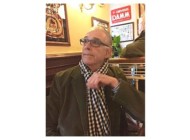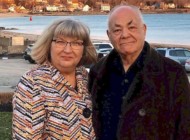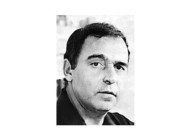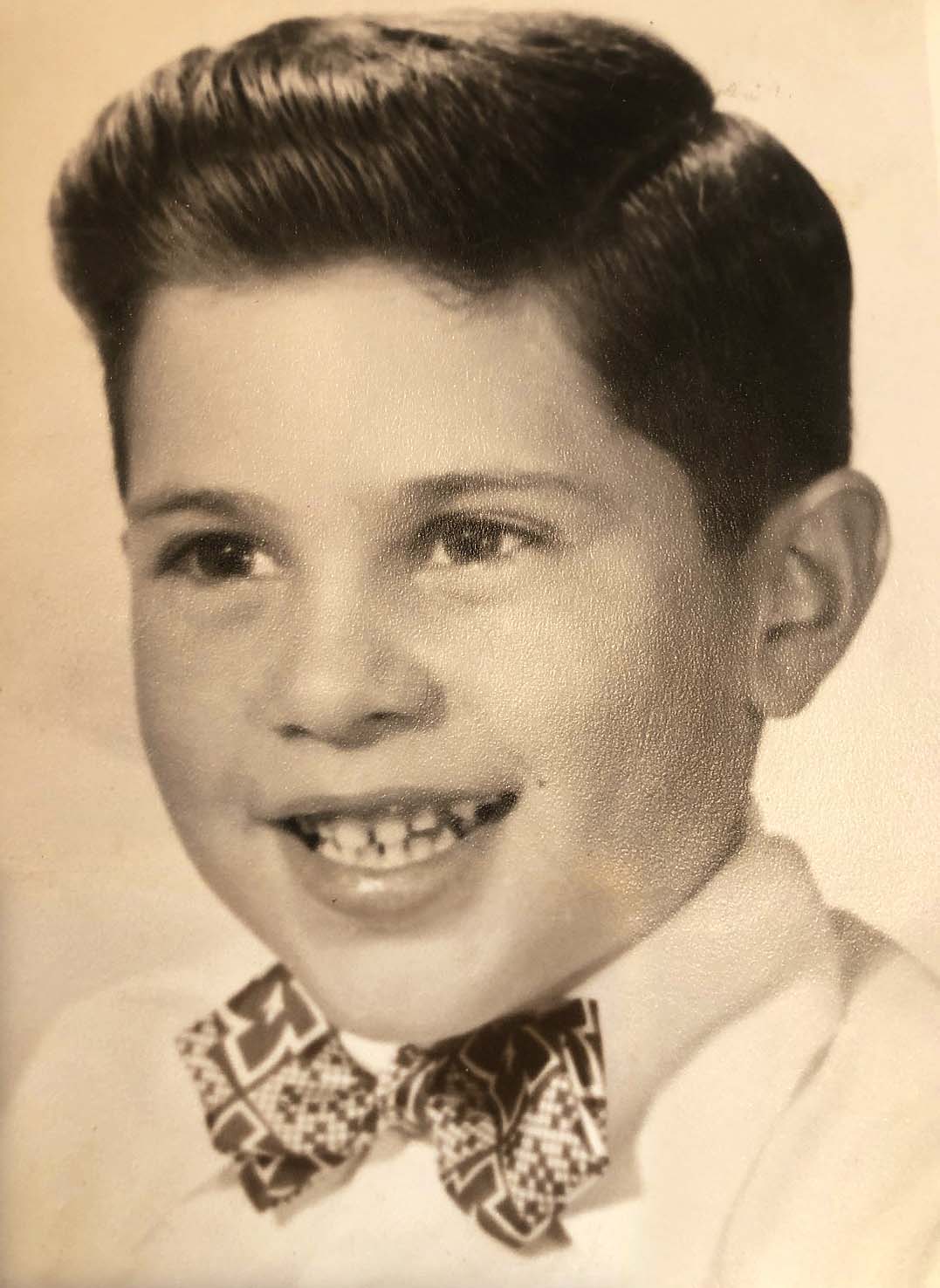
Undated photo of Stephen Score as a boy, courtesy Eleanor Score.
By Madelia Hickman Ring
BOSTON & PROVINCETOWN, MASS. — The folk art and antiques world lost a true legend on Saturday, September 9, when Stephen Score lost his brief but fierce battle with cancer.
He was born in Boston on January 17, 1944, to David and Lillian Score. He attended McGill University in Toronto for an undergraduate degree in psychology, which he followed with a master’s degree in psychology from Boston University. He was an assistant professor at Boston University and did behavioral psychology research at a laboratory in Shrewsbury, Mass.
Stephen met his future wife, Eleanor Angle of Marion, Mass., at the School of Fine Arts where he was teaching an introductory class in psychology. When she called him concerned that she would fail his class, he asked her to the Ritz for lunch. They married on June 10, 1972.
He practiced psychology until his passion for antiques took over. Eleanor recalled Stephen driving a Volkswagen to the lab and coming back with it filled with furniture. “It became apparent that he should become an antiques dealer,” she says.
Stephen opened his first antiques shop in Essex, Mass., in 1978, which was followed with a move to Boston’s Beacon Hill in the early 1990s. Perfectly suited to Stephen’s style and love of color, the 1884 carriage house at 73 Chestnut Street was painted a robin’s-egg-blue and featured a painted trade figure above the front door. Though he closed the shop in 2017, he continued to do shows and work with clients.
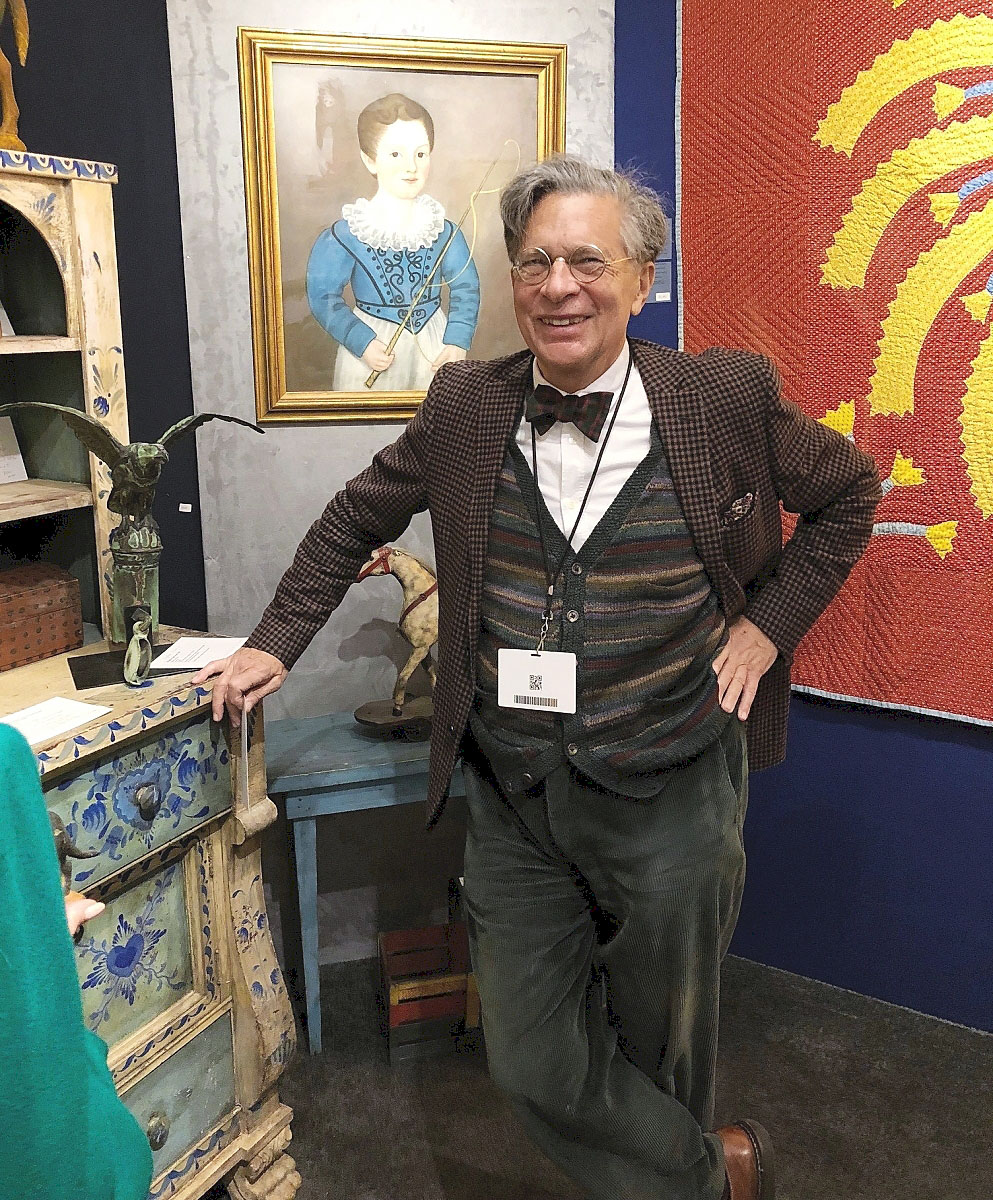
Stephen Score at the 2018 Winter Antiques Show in New York City. Laura Beach photo.
Bertram and Nina Fletcher Little, Steven and Helen Kellogg, Louis Goodman and Peter Goodman (no relation) were some of the iconic collectors of the folk art world that Eleanor remembers Stephen working with and learning from.
Stephen was a fixture in antiques shows in New York City: The Fall Antiques shows at the Seventh Regiment Armory and the Triple Pier Shows in the 1980s and 90s, as well as the American Art Show, which was referred to simply and by most people as “The Folk Art Show.” His last shows in New York City were the Winter Antiques Show (now known as The Winter Show) and, because there was a growing appetite and audience for Twentieth Century primitive and self-taught folk art, the Outsider Art Show.
He also participated in antiques shows around the country, including Philadelphia, Wilmington, Del., Manchester, N.H., Rhinebeck, N.Y., York, Penn., Nashville, Tenn., Hartford, Conn., Fox Valley, Ill., Cedar Rapids, Iowa, and Indianapolis, Ind.
In 2019, Stephen discussed his approach to looking at things with Debbie McArdle of the Chicago Suburban Antiques Dealers Association, in an article published in the Daily Herald. “What is it, now, that pulls me across an aisle, a room, a country? What triggers those tell-tale visceral feelings in my gut? The vibrations of passion I sometimes fear will set off the alarm system at the Met? The truth is I only buy objects I would want to live with. I buy as if I were the collector. Color is a primary determinant. I love color and am not afraid of it. Line — especially sinuous lines that move in lyrical ways, defining a cabriole leg, the body of a bird in a sculpture or the separation between fields of different color. Surface Quality — preferably, untouched surfaces with lovely, old patina, the crackling and crazing and impressionistic build-up of paint layers and wear that give us clues to the experience of the object, itself, over time.”
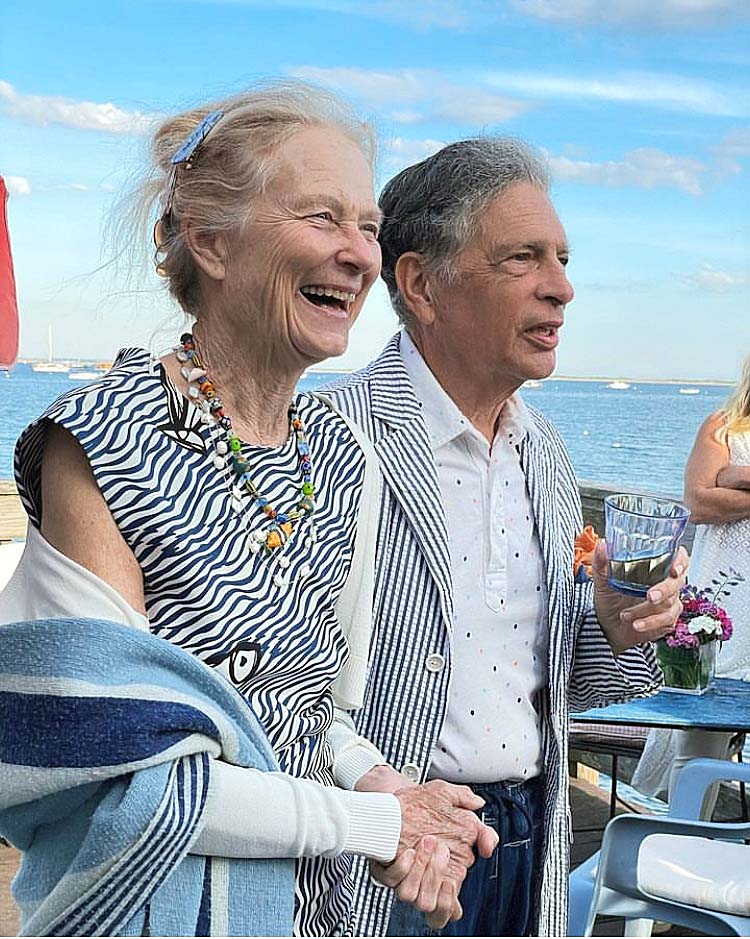
Eleanor and Stephen Score on their 50th wedding anniversary in 2022. Wesley Noonan-Sessa photo.
Stephen handled countless masterpieces in his lifetime that made headlines. An Eighteenth Century portrait of Abigail Rose of North Branford, Conn., which he bought for a client at Skinner’s in 2011, for $1,271,000. In 2006, he bought a Liberty Goddess weathervane by William Henis, for $1,080,000 when it was sold at Christie’s and a horse and rider weathervane by J. Howard & Co, which Stephen acquired in 1990 at Sotheby’s sale of the Bernard M. Barenholtz collection, for $770,000.
Two pieces in particular stand out in Eleanor Score’s mind as ones that Stephen was particularly proud of having handled. “Woman with Two Canaries” by Samuel Addison Shute, which Stephen acquired at Sotheby’s in 1977 for $22,000 and sold to Peter and Barbara Goodman in 1985. When Christie’s sold the Goodman’s collection in January 2022, it brought $1,170,000 and remains the world record auction price for a work by the artist.
Stephen also had a particular affinity for a circa 1740 chest over drawers, with a later painted landscape decoration that he sold to Peter and Barbara Goodman, and which is now in the collection of the American Folk Art Museum.
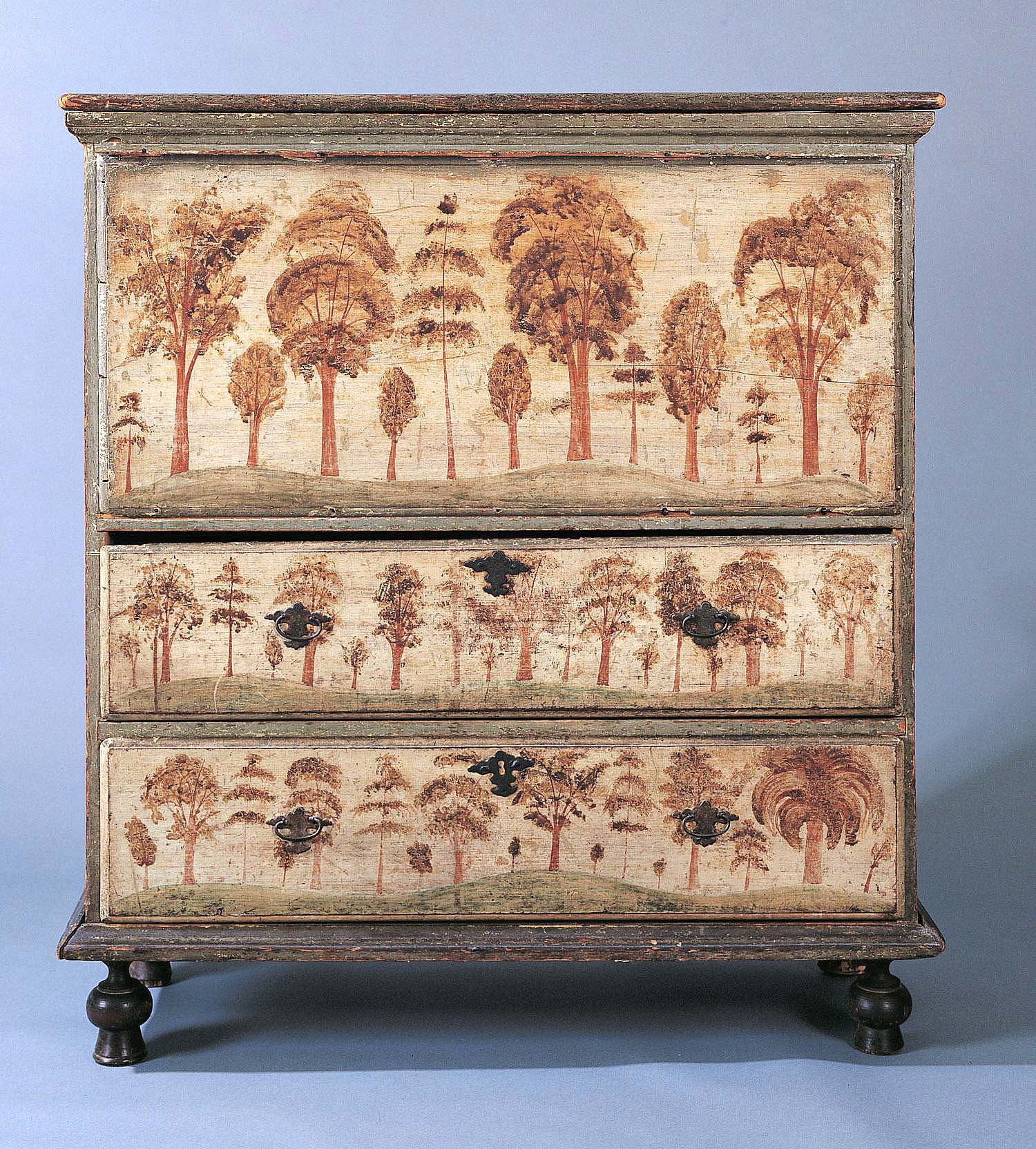
Stephen sold this painted chest over drawers to Peter and Barbara Goodman, who later bequeathed to the American Folk Art Museum. It was one of the pieces he was most proud of handling.
Stephen and Eleanor shared their time between Boston and Provincetown, Mass., most recently and for nearly 10 years in a historic shingled house on Provincetown’s harbor.
Stephen was a loyal member of the Tavern Club, the Harvard Musical Association and the Boston Athenaeum. Some will remember his memorable roles at the Tavern Club, where he played Picasso, a Singing Spanish Prostitute and “Frank Lloyd Wrong.”
He loved traveling to Sicily and Paris and dining out just about anywhere. He always left a restaurant having made real friends with the servers and staff, and often gave toasts to neighboring diner’s tables, even when they were strangers.
Stephen liked to include himself in his ads, interacting with the objects; he will live on in his innumerable advertisements in show catalogs and trade publications, including The Magazine Antiques, Antiques and The Arts Weekly and the Maine Antiques Digest.
Stephen’s last show was the Spring Antiques at Rhinebeck show, May 27-28, 2023. “He did antiques shows until the end,” said Eleanor. “He loved the people. He loved the stuff. He loved the chase.”
“His favorite conversations often revolved around his son, Avram, who he loved to brag about and who he esteemed for his intelligence, his bravery and his great sense of humor,” Eleanor remembers. “Avram kept his spirits up in hospice by singing from Stephen’s favorite operas, U2 songs, ‘Runaround Sue,’…whatever he thought Stephen would like. It mattered so much to Stephen that he was there.”
“When he found a portrait of Grandmother Hobbs in my mother, Jean Angle’s, cellar, she suggested burning it. When he asked ‘Why?,’ she said, “Less it fall into the hands of some antiques dealer!”
Other than Eleanor, Stephen is survived by his son, Avram Score, of Le Boulou, France; his sister, Susan Score Cohen Broutman of Boulder, Colo.; niece Julie Cohen and nephew Jamie Cohen, both of Colorado.
A memorial service for Stephen will take place at 2 pm on Saturday, October 21, at King’s Chapel, 58 Tremont Street, Boston.
Donations in Stephen’s memory may be made to Common Art, a weekly art program conducted through Boston’s Common Cathedral. For more information, www.commoncathedral.org.
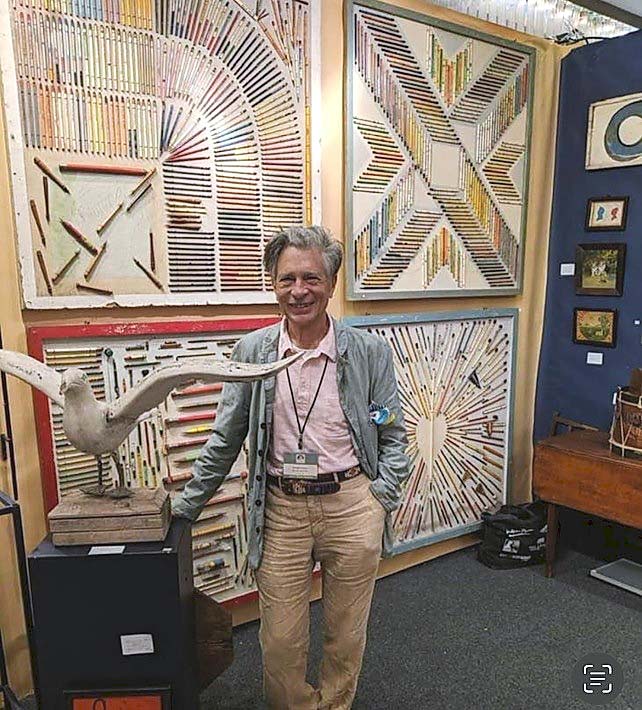
Stephen Score in his booth at the New Hampshire Antiques Dealers Association show in Manchester, N.H.
Stephen Score (1944-2023) – In Memoriam
A light in “our world” has gone out with the absence of Stephen Score. He was an icon in the folk art field and will be greatly missed! He had a great eye for the very best and for the “fun stuff” too.
I’d like to think that by now I am sure Scudder Smith, Pam Boynton, Zeke Liverant, Suzanne Courcier, Bob Cleaves, Bob Skinner, Peggy Schorsch, Burt Savage, Frank Pollack — to name a few — have started an auction house or a great antique show which I am sure Stephen is already participating in with his “family away from home.”
I am so thankful that Stephen crossed my path in life and that I and all of us will always have our favorite memories of our times together to cherish!
Barbara Pollack
Highland Park, Ill.
When I met Stephen Score in the mid-1970s, I was a precocious (some thought obnoxious) kid possessed with an acute skill and knowledge, completely focused on American antiques. My preternatural abilities and outsized personality were not universally embraced or appreciated by many. John Walton famously told me that “Children should be seen and not heard” when I outbid him at an auction in 1981. Stephen Score was quite the opposite. Though nearly 20 years my senior, from our very first meeting he treated me as a peer. I had the utmost respect and genuine admiration for Stephen and truly looked up to him as an example of the kind of dealer I wanted to be. He was always generous with his time and an enthusiastic and supportive mentor. One episode from those early years that Stephen enjoyed recalling centered around a visit to see us in Greenwich, Conn., about 1977. After a tour of my mother’s antique shop in town, Stephen was invited to our home, a few miles away, to see my parents’ collection. Stephen and I would drive together in his car. Quite naturally he asked me if I wished to drive, but was dumbstruck by my response: “Stephen, I am only 13 years old and do not drive.” Apparently, the intensity of our swirling conversations and my comportment had temporarily blinded him to my physical stature and lack of facial hair. This exchange literally cracked him up, and thereafter I was referred to as the “Enfant terrible of the antiques business” by Stephen and Eleanor. Our friendship and business relationship spanned six decades. I greatly admired Stephen’s original and poetic eye, his conviction and passion for the objects and works of art that spoke to him, his integrity, his unique style, his unpretentiousness and his utter delight in the whimsical qualities of American art. Beyond his immeasurable gifts, it was Stephen’s kindness, loyalty, sensitivity and thoughtfulness that I will miss the most. He also shared many experiences and wonderful objects with my mother, Peggy Schorsch (1930-2007), who, like so many others, simply adored him. Stephen was brilliant and possessed a formidable vocabulary and a unique turn of phrase. His written and spoken word were like no one else. Our world is a far less colorful and joyful place without the voice and vision of Stephen Score.
David A. Schorsch
Woodbury, Conn.
Early on, Stephen convinced us to buy a Rufus Porter mural that was on a wall in someone’s house. He was absolutely undaunted by the substantial logistics of getting it out, moving it to us and installing it. When we sold that house about five years ago, he convinced us to let him remove it and he would take it to The Winter Show. Of course, we had questions about what if it didn’t sell, what if it got damaged in transport, but he had utter confidence, and thankfully sold it at the show. That was the thing about Stephen, he was given to the grand gesture. We first met him when we saw one of his ads from when he was in Essex; our first purchase from him was a small theorem watercolor of a bird that we still have. What we mainly purchased were portraits; we were attracted, as was Stephen, by the personality of the sitter. His eye was remarkable, and he was very articulate. He could explain a painting in a way no one else I can think of. I’ll miss all sorts of things about him. His style, which is hard to pin down, just the way he lived his life. I’m a lawyer, he’s totally the opposite. He was, quite simply, really unique.
Louis & Phebe Goodman
Both my wife, Helen, and I were old friends with Stephen and Eleanor. He was pretty new to being a dealer but was extraordinarily helpful early on when we were starting to acquire things for our collection, which at the time was being assembled to furnish an early house in Sandy Hook, Conn. Stephen had a painting that both Helen and I loved but he wasn’t sure if he would part with it, but everyone was very curious to know who had painted the picture, which seemed to have been painted by a pair of artists. Helen, who was always curious about folk art painters, began to research possible combinations, finding and sharing her discoveries with Stephen and gradually narrowing down the list. She ultimately discovered it had been painted by Samuel Addison Shute and Ruth Whittier Shute, a married couple, who traveled through New England looking for portrait commissions. Stephen was emotionally and intellectually involved in that journey and they had a wonderful time corresponding about their findings.
The first thing we bought from him was at the Hartford Antiques show — it was a hooked rug with two horses, one black, the other red. It was graphically very powerful. When we downsized our collection with Ron Bourgeault and Northeast Auctions in 2011, it brought about $70,000, which I think was a record for a hooked rug at that time.
When Helen died a couple of years ago, Stephen wrote a beautiful letter about her, their friendship and her inexhaustible curiosity about folk art. He had a wonderful aesthetic intuition and made the discovery of folk art an intriguing discovery for everyone concerned.
Steven Kellogg
I first met Stephen in the spring of 1977, when he came to a sale at Sotheby’s Parke Bernet when it was still on Madison Avenue, at 77th Street. He came to look at a Samuel Shute portrait of a woman with a white face and appliqued parakeets and ribbons. It was a picture that came out of nowhere and it just took off without the competition of any of the heavy hitters who were active at that time. Stephen and Eleanor bought it; I had no idea of who they were or how developed his business was at that point. He paid $22,000, which was a bold move and a lot of money at the time.
We became close friends but the longest and most sustained period of time we worked together was for the Bert and Nina Fletcher Little sale in 1994. The family didn’t really know Sotheby’s well, we didn’t have an in-depth relationship, and the kids decided to have Stephen act as a consultant and to oversee the whole process. He and I worked every molecule of that sale together, the order of the sale, etc.
He was really an extraordinary person. He was passionate about the material and had a very sort of visceral response to things. When I think about the commonality of all the things he handled over the years, there was a humor, a wit, something special — not necessarily the kind of cookie cutter or traditional rendition of a particular artist’s work. He could perceive the quality of something beneath the radar. His instinct was right on but not always on the most popular or accepted pathway. He was iconic and unique. There are not many people who have his intellect and his range of sensitivity to all different kinds of art. He was very surefooted; he knew he knew. He could interpret what was visible and also what was underneath — that was his sweet spot.
Nancy Druckman
New York City
I bet I knew him 50 years. Even early on, he always had a real presence, in his own quirky way. He could be irascible and challenging and also really funny. As much as anyone, he had a very discerning eye. His aesthetics were more eclectic than many people think or would know. He made a real impact on the folk art market and would talk nostalgically about Bertram K and Nina Fletcher Little or Mary Allis — he knew a lot of those folks at the end of their collecting or dealing lives. I always had tremendous respect for him. He could be extremely thoughtful and very sensitive. When he had his shop on Beacon Hill, it was very diverse, European as well as American things. I’ve never known anyone quite like him.
Stephen Fletcher
Executive Vice President, American Furniture & Decorative Arts
Bonhams Skinner, Boston
Stephen was always someone you looked to for of his eye and what he would land on and what he would focus on, what he would put out there to the public. He didn’t buy instantaneously, he would examine, ponder an object from every angle, spend lots of time looking; he really internalized the material. More than most, he looked at things in terms of their intrinsic beauty, the soul of an item.
Once an item resonated with him, he could wax poetic, turn an object into an animate being. He was the most brilliant salesman. I learned this from him, years ago when the folk art shows were at the piers. He had a very expensive cutlery box and a woman was pondering whether to buy it. She said to him, “Stephen, I just don’t know where I’d put it,” and he said, “If you can afford it you can afford to be casual with it.” Meaning, if you love something you’ll find a place for it, it doesn’t have to have primacy of place.
Everyone will tell you he was a completely unique individual in terms of his personality. He was also a consummate gentleman, polite to the very end. If he came into our booth and liked something or how we’d associated objects, he was always sincere and very complimentary. He could make suggestions in a way that was constructive. I can honestly say that there were certainly many things he acquired that I was envious of, so many times I was outbid by him. But I was never jealous of him. There was never anything from him that was vindictive or mean spirited. He was the greatest person to have in the club. That mischievous twinkle and grin will surely be missed.
Pat Bell
Olde Hope, New York City & New Hope, Penn.
To say they broke the mold with Stephen is an understatement. He was one-of-a-kind. Stephen had an impeccable design sense, an intuitive color sense, and an exceptional “eye” for design. He mixed time periods, styles, textures and materials with flair. At shows, there was anticipation at what Stephen would bring and how it would be displayed. The results were always eye-popping — sometimes controversial — and that was one of the many beauties of Stephen. He wasn’t afraid to break barriers or take risks and had fun doing so with a wry smile and sense of humor! His shop was located in Boston, and on one occasion, years ago, when he was at the magazine (then in Watertown) for an ad photo shoot, he came into my office. Displayed on my walls were examples of artwork by my children. He was so enthusiastic about their work that he asked if they’d create more, saying he’d hold an exhibit at his gallery for them. Stephen was so supportive and enthusiastic about the world around us — whatever the subject or creator. Stephen was a gentleman, a friend and made a mark in the trade that will live on. A selection of words to describe Stephen: gentleman, wise, witty, funny, playful, clever, enthusiastic, precise, discerning, daring, inimitable, impeccable, intellectual, intelligent, knowledgeable, passionate, opinionated, competitive, supportive, trend-setter, colorist, designer, mentor, icon, legend, singular, exceptional, colleague, friend — a rare INDIVIDUAL. You are and will be missed, Stephen Score.
Johanna McBrien
Consulting editor, Incollect Magazine (formerly Antiques & Fine Art)
Director, Dedham Museum & Archive (formerly Historical Society)
I am at a loss for words…When Stephen and I got together we always had such a great time. Really, chatting about everything other than the business. My most recent visit with Stephen was just a few months ago when Stephen introduced me to one of his old collectors in Boston.
Being around Stephen was refreshing.
Fred Giampietro
New England Auctions,
Branford, Conn.
I loved Stephen and respected his eye tremendously. He was such a showman! Wonderful creative booths with an eye toward the art of each object — he was a master at that.
Karen DiSaia
Stephen was a deeply inspiring collector with a great enthusiasm for folk art. His unique eye and passion will be sincerely missed in our community.
Jason T. Busch
Becky & Bob Alexander, director and chief executive officer,
American Folk Art Museum
I always approached Stephen’s booth at any antiques show with a slight sense of trepidation yet excitement. His unique theatrical personality was always somewhat unpredictable, and listening to him wax poetic about one of his discoveries seemed to require a bucket of popcorn and an appreciation of live (sometimes absurdist) performance. But in the end, you walked away with an expanded perspective, because the theatrics overlay a deep intellectual, as well as aesthetic, engagement with art and objects that continually set standards of excellence in an ever-changing field.
Stacy Hollander
We were not customers but did make one of our very first folk art purchases from his booth. At least 35 years ago we were at an antiques show — maybe in Westchester — and we saw a mourning picture we liked (I was in graduate school at the time and had written a paper on mourning art so I had to have an example). Stephen had stepped away from the booth and asked Vera and Pepi Jelinek to watch things. We bought the piece, but it was the Jelineks who sold it to us!
I will also never forget his booth at The Winter Show in NYC in 2018, where he had a live model — and we were all so taken with her that I couldn’t tell you what he was selling! He definitely believed in spectacular displays.
Elizabeth Warren
President, Board of Trustees, American Folk Art Museum
I met Stephen in the fall of 2012 when my father, Wesley T. Sessa, and I were doing the South Norwalk Show right after Hurricane Sandy. Stephen was in the booth next to us. There were times when it was slow, so of course we struck up conversation. I helped him with sending a photo of a quilt in his booth to someone and later, after the show, my father and I delivered a trade sign he had sold to one of his clients in Philadelphia, where we live. Stephen mentioned he was doing the Philadelphia Show, and could I help him? That was the first show I worked with him on. After that, I helped him with many shows over the next 10 years, including ones in New York City; New Hampshire; Delaware; Nashville; Illinois; Rhinebeck; and York, Penn.
I would do whatever needed doing, from suspending unique and unwieldy objects so they appeared to be floating, to finding a nice pea soup and half a “some sort of” sandwich for lunch. When I was nervous that the booth would not be setup in time, he would not convey urgency but the confidence that we would have the booth ready for the opening, even if we used every last second. In these situations, he surrounded himself with people whom he trusted and had confidence in.
During the shows, Stephen could make a conversation about an object into a therapy session. He would sometimes even forgo a potential sale to help someone. I think that goes back to his work as a therapist before he was a folk art dealer. At certain points, you could see on people’s faces how interacting with Stephen brought them relief and comfort; it was quite amazing.
Stephen and I spent a lot of time driving to shows together. On the occasion he would see a house that had the right surface and character, he would grab my arm and say, “Oh, Wesley, imagine if this was home.”
I have many great memories of spending time with Stephen and Eleanor in Provincetown, watching the cosmos sway in the breeze as we talked about anything and everything, except for the antiques business.
He was more than someone I worked for; he was a dear friend. His aesthetic and the lens through which he saw the world is something to aspire to. It was a privilege and a pleasure to work with him at shows. He was one of the greatest teachers I have ever had.
Wesley Noonan-Sessa
The loss of a legend! There has been a lot written and said about Stephen’s genius with regards to his contributions to the art world. His ability to find the humanity and soul in the idiosyncratic self-expression of self-taught artists will endure forever as a testament to how he changed our perceptions and appreciation.
However, for those who knew him, beyond his professional career as purveyor of beauty, master showman, amazingly bright, entertaining, witty and always ready to educate and enlighten, was his humanity.
He never knew a stranger, never missed an opportunity to encourage, support or help. His generosity of spirit was always present. His devotion to family and friends was always a primary concern.
We should all be so fortunate to leave this world, not only a better place than we found it, but a kinder place like Stephen did.
To my dearest friend and colleague of 50 years, as I said the last time we spoke, “This is not good-bye, but I will see you later.”
You will be missed and know you were loved.
Gerald Roy
Pilgrim/Roy
[Eleanor Score shared with Antiques and The Arts Weekly the following letter from Tom van Deest to Josh Guild]
Hello Josh,
I cannot begin to express my gratitude for your call this morning. It was at once very upsetting but also comforting to know a valued friend was being cared for by those who loved him.
I was aware of Stephen Score for some time prior to actually meeting and befriending him in the early 1980s when he began doing a show in Woodstock, Ill., that I did.
In those early days, who hadn’t heard of Stephen Score? His exploits were well chronicled in the Maine Antiques Digest. Who was this high roller? And how could someone of his status become friends with a significantly lesser known dealer in Iowa?
Prior to getting to know him, I first spotted him at the Home in Indiana Show. Guess what he was doing? He was moving back and forth in his booth while attempting to place an apple perfectly on a green plant stand. He would move the apple ever so slightly, move back to observe the placement and move again until perfect for his presentation. I am certain that very kind of practice was repeated often during your life with him.
Stephen was impish and seemed to often elicit smiles with his ads, placement in group photographs or willingness to try on attire (a clown’s button jacket I had in my booth comes to mind). He was self-deprecating and his humor both subtle and dry. He laughed at himself, and I was entertained by his antiques world associations, experiences and contacts. You could listen to him for hours.
I already told you of his thoughtfulness toward me regarding his action after learning of my little daughter’s accident and broken arm and, later, his kind offer to me following my wife’s death.
Stephen routinely sent messages during Covid isolation punctuated by humorous videos regarding masking. Our most recent conversation came from his request for the name of a Midwest artist who had created a metal sculpture he was selling. That seems like only several months ago, so quite recent.
How fleeting life is! Doing a show requesting information and then, suddenly, on death’s bed.
Clearly, Josh, you were much more than a quality assistant. You knew his thoughts and tendencies. I could confide in you knowing it would be just fine with Stephen; you were his extension and spokesman. You looked out for him.
When we closed our conversation, I sensed both our voices broke. What greater homage to a friend than the sincere sadness and emotion rendered by friends of his near passing? Please count me as one of those and I join you in saluting a good and humble man who was our friend.
Thank you, Josh, Stephen was lucky to have such a quality man as his friend.
Sincerely
Tom van Deest
It’s hard to believe anyone as vibrant and enthusiastic as Stephen Score is gone. I met him at one of the first shows he ever did, and purchased a watercolor of Moses in the Bullrushes that I really didn’t want. I knew at that moment that he had an amazing eye and was a great salesman. He shall be missed.
Joan Johnson
Stephen was one of the great dealers of American folk art. I was honored to work with him for the many years he exhibited with me at the Fall Antiques Show and The Philadelphia Antiques Show. He had an amazing eye and will be remembered as one of the legendary dealers of the Twentieth Century. He will be missed.
Sanford Smith
New York City
Dear Eleanor, Avram and the family of Stephen Score. A gentleman of class, elegance, impeccable taste and humility would only begin to describe Stephen as the wonderful human being he was. From his personal style to the creative imagery he portrayed using objects and art, one could always recognize Stephen’s “signature” display among 100 fellow professionals…a master of his craft and well deserving of that title. With the family’s consent, I was one of few visitors to spend precious time with Stephen a few weeks ago at Cape Cod Hospital where he was amazingly and gently cared for. I will never forget the smile on his face when I said, “Stephen, you have to get out of this hospital as I have a weathervane in my car that I want to sell you”; we both laughed, and a lighter moment filled the room with a glow in his eyes and a smile on his face. It was hard to leave Stephen that day but a warm hug, stroke of his hair and solid handshake accompanied me on my way home hoping we will meet again someday. We have all lost a treasured part of ourselves in Stephen’s passing, as his talent, creativity and appreciation for all things beautiful will never fade for those of us who loved him. May he be graced in Heaven and rest in peace.
Frank Gaglio and Family
As a reporter for various antiques trade publications for the past 40 years, I have covered hundreds of antiques events. My husband and I have gone coast to coast, to large and small shows and auctions. and we have met thousands of those in the antiques trade. We interviewed and took pictures of objects and people. But Stephen stood out. He was always eager to chat and share stories, pose for pictures and take the time to talk about his booth or about his life. He was a giant in his field. We thank him for what he gave us all, and we send a special thank you also to his wife whom we met at an antiques show.
Fran & Herb Kramer

















